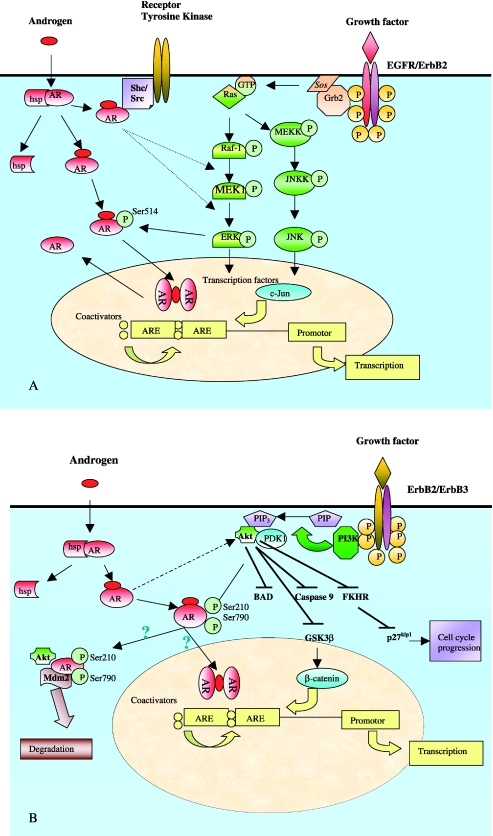Figure 1.
(A) The interaction between the AR and the ErbB/MAPK pathway. Parallel pathways activated by androgen and the ErbB receptor intersect at several levels. Following hormone binding in the cytoplasm, the AR-hsp-containing complex is dissociated and the steroid receptor is rapidly translocated to the nucleus. In the nucleus, AR dimerizes and binds to the DNA double helix at specific sequences called AREs. The DNA-bound AR dimer recruits a multiprotein complex containing members of the basal transcription machinery and other coactivators or corepressors (not shown), which control the transcriptional AR response. AR is then dissociated from the DNA and shuttled back to the cytoplasm where it can reassociate with hsp or ligand. Growth factors initiate signalling by binding to and sequentially activating the ErbB receptors, adaptor molecules like Grb2 and Sos, and the GTP exchange factor Ras. This in turn activates the three-tiered MAPK cascade. Crosstalk may occur in the cytoplasm, for example, when AR complexes with Shc/Src (two adaptor molecules recruited by activated receptor tyrosine kinases) to activate the MAPK pathway, leading to phosphorylation of ERK. Alternatively, ErbB2 activates the AR through ERK phosphorylation at Ser514, thereby suggesting an influence of these two pathways on each other. c-Jun is activated downstream of MEKK, which enhances the homodimerization of AR with DNA and consequently the AR response to androgen. The requirement for AR in MEKK1-induced apoptosis is not shown in this figure. (B) The interaction between AR and ErbB/PI3K/Akt. Similar to (A), ligand binding of the AR initiates dissociation from hsp, phosphorylation, and dimerization. Growth factors activate ErbB2/ErbB3 complex and recruit PI3K, which produces 3′-phosphoinositides (PIP3) and recruits PDK1 and Akt, resulting in their activation. Akt then inactivates a variety of proapoptotic molecules including Bad, caspase 3, GSK-3β, and the forkhead transcription factors (FKHR). In addition, Akt targets the AR and phosphorylates it at Ser210 and Ser790. This phosphorylation promotes PC cell survival by controversial mechanisms (marked by the question marks). Some workers hypothesize that this is through activation of AR transcription. Alternatively, it may protect the cells from androgen-induced apoptosis through ubiquitylation and degradation of the AR within an Akt/Mdm2/AR complex. Another mechanism of AR activation by Akt is through GSK-3β inactivation and nuclear accumulation of β-catenin. In the cytoplasm, AR rapidly activates PI3K and increases intracellular PIP3 by an as yet unknown mechanism. PTEN, the negative regulator of this pathway, is not shown in this figure.

